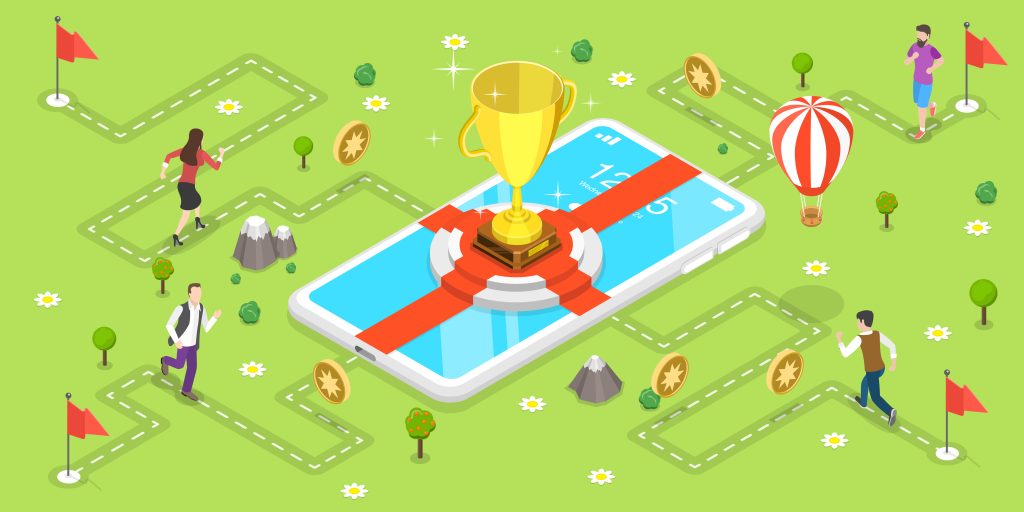You’ve likely encountered the term ‘gamification and ai’ before, especially on my blog, where I write about it frequently.
Actually, just few weeks ago I was thinking about a similar topic Ai in Gamification, but I was looking on the industry with different lense.
So today, we’ll talk about how AI will shape the future development and growth of this playful industry.
Gamification is a strategy that businesses and educators have used to foster a deeper level of interaction and engagement. But the game changes entirely when artificial intelligence (AI) enters the equation, introducing a world of personalized, adaptive experiences that take gamification to unprecedented heights.
This comprehensive guide aims to demystify the role of AI in gamification, its implications across different sectors, and how you can harness its transformative potential for exponential growth.
Unpacking Gamification AI
While the principle of gamification is relatively straightforward – integrating game mechanics into non-gaming contexts for increased user interaction – the concept of AI in gamification can appear a tad more complex.
In simple terms, Gamification AI marries the strengths of AI technology with gamification strategies. This blend takes user experience beyond standard gamification, offering personalized, engaging encounters that align with individual user behaviours, preferences, and learning styles. Doing so unlocks greater user engagement and contributes to overall business expansion.
Capitalizing on Personalization
In the age of customization, personalization is a vital differentiator this technology holds a significant edge. By processing user data and integrating machine learning algorithms, these AI-driven systems offer adaptive content and challenges that resonate with users’ interests, abilities, and progress, ensuring continuous engagement and motivation.
Harnessing Real-time Feedback and Adaptive Learning with Gamification AI
A gamification system, campaign or process, enhanced with Artificial Intelligence not only allows personalized experiences but also offers real-time feedback and adaptive learning. The AI system analyses user behaviour and performance, pinpoints areas of excellence or difficulty, and accordingly adjusts challenge levels, offers targeted prompts, or suggests alternative learning paths. This dynamic model promotes sustained user engagement and satisfaction while fostering long-term retention and loyalty.

The Impact of Gamification AI across Industries
AI-driven gamification holds transformative potential for user engagement and experience across various sectors. A few prominent applications include:
Education
AI-powered gamified systems and curiculums can construct tailored learning routes for students, adapting to their unique learning methods and progress. This strategy enhances motivation, engagement, and overall educational outcomes.
Healthcare
In the healthcare sector, it can create compelling, individualized patient experiences that promote healthy behaviours and adherence to treatment plans.
Marketing
It assists businesses in enhancing customer engagement and conversion rates by launching personalized marketing campaigns.
Human Resources
In HR, it can be deployed to create immersive and personalized training resources for employees, facilitating quick and efficient skill and knowledge acquisition.
Leveraging Gamification AI Successfully
To effectively adopt gamification AI, consider the following steps:
- Define Your Objectives
Identify the objectives you aim to achieve with gamification and AI, such as improved user engagement, retention, or conversion rates. - Select the Appropriate AI Platform
Conduct thorough research and choose an AI platform that aligns with your objectives and offers the necessary tools and features. - Formulate a Gamification Strategy
Design a comprehensive plan that integrates AI-driven customization and adaptive learning. - Monitor and Refine
Regularly analyze user data and feedback to fine-tune your approach and ensure optimal results.
Pioneering Examples of Gamification AI
Gamification with itegrated AI logic has already demonstrated its potential in popular apps like Duolingo, a language-learning platform.
Duolingo uses AI algorithms to personalize each user’s learning journey, adjusting lessons to their skill level, interests, and progress. The incorporation of game-like elements such as points, levels, and streaks keeps users engaged and motivated in their lessons.
Another innovative application is the fitness app, Zombies, Run! This app turns a regular workout into a captivating, narrative-driven adventure, with the AI adapting the story based on the user’s progress and performance.
These instances illustrate the transformative power of this technology in redefining user experiences and driving user engagement, motivation, and loyalty across various sectors.
Conclusions and Key Takeaways
AI-powered gamified system is a potent tool that can revolutionize user engagement and experience across industries. By leveraging personalized and adaptive learning driven by AI, we can create immersive, interactive experiences that engage and motivate users.
Here are some key takeaways:
- Gamification is a widely adopted strategy for creating engaging user experiences.
- It is the convergence of AI technologies with gamification, amplifying the effectiveness of gamified experiences to create a more personalized and engaging user experience.
- It has widespread applications, including education, healthcare, marketing, and HR.
- When implementing, it is crucial to define your goals, develop a strategy, track, and optimize its use.
By following these steps, you can unlock the full potential of this exciting cross of new technologies, gaining a competitive edge in today’s digital landscape.
